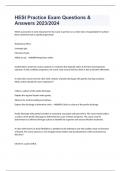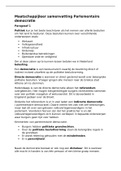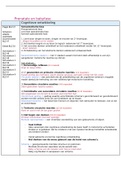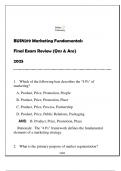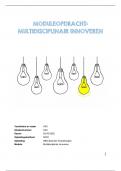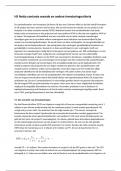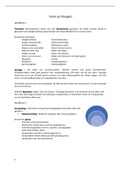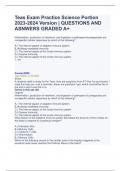Deception in Clinical Settings – Literature
Week 1
Clinical Assessment of Malingering and Deception: Chapter 1
An introduction to response styles
Mental health professionals may wish to consider what level of deception should be
documented in their reports
One reasoned approach would be to record only consequential deceptions
However, what should be done with inconsequential distortions? (Ones that are
difficult to categorize)
Two extreme alternatives are presented:
(1) Taint hypothesis – any evidence of non-genuine responding is likely to signal dishonesty
and practitioners should document any observed deceptions
(2) Beyond-reasonable-doubt standard – only conclusive evidence of a response style, such
as feigning, should be reported
In forensic practice, determinants of malingering are generally understood as playing a
decisive role in legal outcomes – such as pretending to be mentally ill for a lesser sentence
Mental health professionals must decide what evidence of response styles should be
included in forensic reports – their decisions are likely to be influenced by at least two
dimensions: (1) accuracy versus completeness of their conclusion
(2) use versus misuse of clinical findings by others
Fundamentals of response styles
Basic concepts and definitions
Nonspecific terms
Researchers want precision in the description of response styles so why use nonspecific
terms?
The author finds a common error to be overspecification of response styles
E.g.: Criminal offenders are often miscategorized as malingerers simply because of
their manipulative behaviour
Practitioners try to determine which specific response style best fits the clinical data
and this results in the specification of a response style, even when the data are
inconclusive
A two-step approach is recommended for minimizing overspecification:
This approach asks practitioners to make an explicit decision between general and specific
response styles
Clearly, conclusions about specific response styles are more helpful to clinical
conclusions than nonspecific descriptions
Unreliability
Raises question about the accuracy
of reported information – useful
when faced with conflicting clinical
data
,Nondisclosure
Withholding information – an individual if free to choose whether they want to share
or not
Self-disclosure
Refers to how much is shared – high self-disclosure is because of being more open,
which is important in the context of reciprocal relationships. Low self-disclosure dos
does not mean someone is dishonest
Deception
Any consequential attempt to distort or misrepresent their self-reporting – includes
acts of deceit and nondisclosure
Dissimulation
Wide range of deliberate distortions or misrepresentations of psychological
symptoms
Overstated pathology
Important distinctions must be made between malingering and other terms used to
describe overstated pathology!
Recommended terms to categorize overstated pathology:
(1) Malingering
The intentional production of false or grossly exaggerated physical/psychological
symptoms, motivated by external incentives
It must be the fabrication of multiple symptoms
The presence of minor exaggerations does not qualify as malingering
Does not rule out co-occurrence of internal motivations
(2) Factitious presentations
The intentional production or feigning of symptoms that is motivated by the desire
to assume a sick role
Requires some unspecified internal motivation
(3) Feigning
The deliberate fabrication or gross exaggeration of psychological/physical symptoms,
without any assumptions about its goals
This term is used because psychological tests (measuring response styles) have not
been validated to assess a person’s specific motivations
o Thus, determinations can be made for feigned behaviour but not their
underlying motive (malingering)
Three terms to be avoided in clinical and forensic practice are summarized:
(1) Suboptimal effort
This term is often misused as a proxy for malingering
However, it lacks precision and may be applied to nearly any client or professional
,(2) Overreporting
Some equate this term with feigning
However, it lacks clarity with respect to its content
(3) Secondary gain
This term does not have clear definitions
Secondary gain means something different to a psychoanalyst a health care provider and a
forensic expert
Stimulated adjustment
Three related terms are used to describe response styles that are associated with simulated
adjustment:
(1) Defensiveness
The opposite of malingering
o denial or gross minimization of physical/psychological symptoms
Must be distinguished from ego defences (that involve intrapsychic processes to
distort perceptions)
(2) Social desirability
The tendency to present oneself in the most favourable manner
Social desirability is a far more encompassing construct than defensiveness
(3) Impression management
The deliberate effort to control others’ perceptions of an individual (maximizing
social outcomes to the portrayal of a desired identity)
This term is often construed as more situationally driven than social desirability
Although assumed that impression management involves only a prosocial
perspective, people may use it for a variety of purposes (etc. playing dumb)
Preferred terms for simulated adjustment are likely to vary by the professional setting
Clinically, defensiveness is often the most precise term to describe a person’s minimization
of psychological difficulties
Efforts at self-presentation are likely to involve both social desirability and impression
management
Other response styles
Four other response styles (that are not understood well) are outlined:
(1) Irrelevant responding
The individual does not become mentally engaged in the assessment process
This process of disengagement may reflect intentional disinterest or simply
carelessness
(2) Random responding
This style is a subset of irrelevant responding based entirely on chance factors
, (3) Acquiescent responding
This style is commonly referred to as yea-saying, which is rarely experienced in its
pure form (indiscriminately agreeing)
This term is clearly distinguishable from social desirability
(4) Disacquiescent responding
This term is the opposite of acquiescent responding
When used on scales focused on pathology, disacquiescent essentially eliminates
elevations on feigning indicators
(5) Role assumption
Individuals may assume the role or character of another person in responding to
psychological measures
This response style is poorly understood but potentially important
(6) Hybrid responding
Describes an individual’s use of more than one response style in a particular
situation
E.g.: clients may show honest responding about most facets of their lives but engage
in defensiveness with respect to substance abuse
Domains of dissimulation
Response styles are almost never pervasive
E.g.: malingerers do not feign everything from viral infections to intellectual disabilities
A convenient framework for understanding and assessing response styles is the concept of
domains
Three broad domains encompass most attempts at dissimulation:
(1) Feigned mental disorders
(2) Feigned cognitive abilities
(3) Feigned medical complaints/symptoms
These domains are important to assessment of response styles, because detection
strategies are rarely effective across all domains
Common misconceptions about malingering
-> held by both practitioners and the public:
1) Malingering is rare
2) Malingering is a static response style
a. Some practitioners use the flawed logic: “once a malingerer, always a
malingerer”
b. Most efforts at malingering appear to be related to specific goals in a
particular context
Week 1
Clinical Assessment of Malingering and Deception: Chapter 1
An introduction to response styles
Mental health professionals may wish to consider what level of deception should be
documented in their reports
One reasoned approach would be to record only consequential deceptions
However, what should be done with inconsequential distortions? (Ones that are
difficult to categorize)
Two extreme alternatives are presented:
(1) Taint hypothesis – any evidence of non-genuine responding is likely to signal dishonesty
and practitioners should document any observed deceptions
(2) Beyond-reasonable-doubt standard – only conclusive evidence of a response style, such
as feigning, should be reported
In forensic practice, determinants of malingering are generally understood as playing a
decisive role in legal outcomes – such as pretending to be mentally ill for a lesser sentence
Mental health professionals must decide what evidence of response styles should be
included in forensic reports – their decisions are likely to be influenced by at least two
dimensions: (1) accuracy versus completeness of their conclusion
(2) use versus misuse of clinical findings by others
Fundamentals of response styles
Basic concepts and definitions
Nonspecific terms
Researchers want precision in the description of response styles so why use nonspecific
terms?
The author finds a common error to be overspecification of response styles
E.g.: Criminal offenders are often miscategorized as malingerers simply because of
their manipulative behaviour
Practitioners try to determine which specific response style best fits the clinical data
and this results in the specification of a response style, even when the data are
inconclusive
A two-step approach is recommended for minimizing overspecification:
This approach asks practitioners to make an explicit decision between general and specific
response styles
Clearly, conclusions about specific response styles are more helpful to clinical
conclusions than nonspecific descriptions
Unreliability
Raises question about the accuracy
of reported information – useful
when faced with conflicting clinical
data
,Nondisclosure
Withholding information – an individual if free to choose whether they want to share
or not
Self-disclosure
Refers to how much is shared – high self-disclosure is because of being more open,
which is important in the context of reciprocal relationships. Low self-disclosure dos
does not mean someone is dishonest
Deception
Any consequential attempt to distort or misrepresent their self-reporting – includes
acts of deceit and nondisclosure
Dissimulation
Wide range of deliberate distortions or misrepresentations of psychological
symptoms
Overstated pathology
Important distinctions must be made between malingering and other terms used to
describe overstated pathology!
Recommended terms to categorize overstated pathology:
(1) Malingering
The intentional production of false or grossly exaggerated physical/psychological
symptoms, motivated by external incentives
It must be the fabrication of multiple symptoms
The presence of minor exaggerations does not qualify as malingering
Does not rule out co-occurrence of internal motivations
(2) Factitious presentations
The intentional production or feigning of symptoms that is motivated by the desire
to assume a sick role
Requires some unspecified internal motivation
(3) Feigning
The deliberate fabrication or gross exaggeration of psychological/physical symptoms,
without any assumptions about its goals
This term is used because psychological tests (measuring response styles) have not
been validated to assess a person’s specific motivations
o Thus, determinations can be made for feigned behaviour but not their
underlying motive (malingering)
Three terms to be avoided in clinical and forensic practice are summarized:
(1) Suboptimal effort
This term is often misused as a proxy for malingering
However, it lacks precision and may be applied to nearly any client or professional
,(2) Overreporting
Some equate this term with feigning
However, it lacks clarity with respect to its content
(3) Secondary gain
This term does not have clear definitions
Secondary gain means something different to a psychoanalyst a health care provider and a
forensic expert
Stimulated adjustment
Three related terms are used to describe response styles that are associated with simulated
adjustment:
(1) Defensiveness
The opposite of malingering
o denial or gross minimization of physical/psychological symptoms
Must be distinguished from ego defences (that involve intrapsychic processes to
distort perceptions)
(2) Social desirability
The tendency to present oneself in the most favourable manner
Social desirability is a far more encompassing construct than defensiveness
(3) Impression management
The deliberate effort to control others’ perceptions of an individual (maximizing
social outcomes to the portrayal of a desired identity)
This term is often construed as more situationally driven than social desirability
Although assumed that impression management involves only a prosocial
perspective, people may use it for a variety of purposes (etc. playing dumb)
Preferred terms for simulated adjustment are likely to vary by the professional setting
Clinically, defensiveness is often the most precise term to describe a person’s minimization
of psychological difficulties
Efforts at self-presentation are likely to involve both social desirability and impression
management
Other response styles
Four other response styles (that are not understood well) are outlined:
(1) Irrelevant responding
The individual does not become mentally engaged in the assessment process
This process of disengagement may reflect intentional disinterest or simply
carelessness
(2) Random responding
This style is a subset of irrelevant responding based entirely on chance factors
, (3) Acquiescent responding
This style is commonly referred to as yea-saying, which is rarely experienced in its
pure form (indiscriminately agreeing)
This term is clearly distinguishable from social desirability
(4) Disacquiescent responding
This term is the opposite of acquiescent responding
When used on scales focused on pathology, disacquiescent essentially eliminates
elevations on feigning indicators
(5) Role assumption
Individuals may assume the role or character of another person in responding to
psychological measures
This response style is poorly understood but potentially important
(6) Hybrid responding
Describes an individual’s use of more than one response style in a particular
situation
E.g.: clients may show honest responding about most facets of their lives but engage
in defensiveness with respect to substance abuse
Domains of dissimulation
Response styles are almost never pervasive
E.g.: malingerers do not feign everything from viral infections to intellectual disabilities
A convenient framework for understanding and assessing response styles is the concept of
domains
Three broad domains encompass most attempts at dissimulation:
(1) Feigned mental disorders
(2) Feigned cognitive abilities
(3) Feigned medical complaints/symptoms
These domains are important to assessment of response styles, because detection
strategies are rarely effective across all domains
Common misconceptions about malingering
-> held by both practitioners and the public:
1) Malingering is rare
2) Malingering is a static response style
a. Some practitioners use the flawed logic: “once a malingerer, always a
malingerer”
b. Most efforts at malingering appear to be related to specific goals in a
particular context


